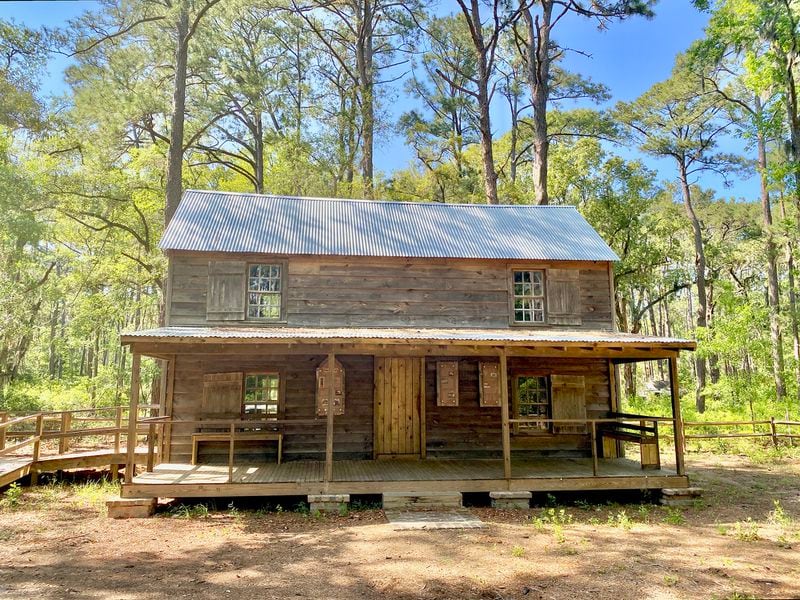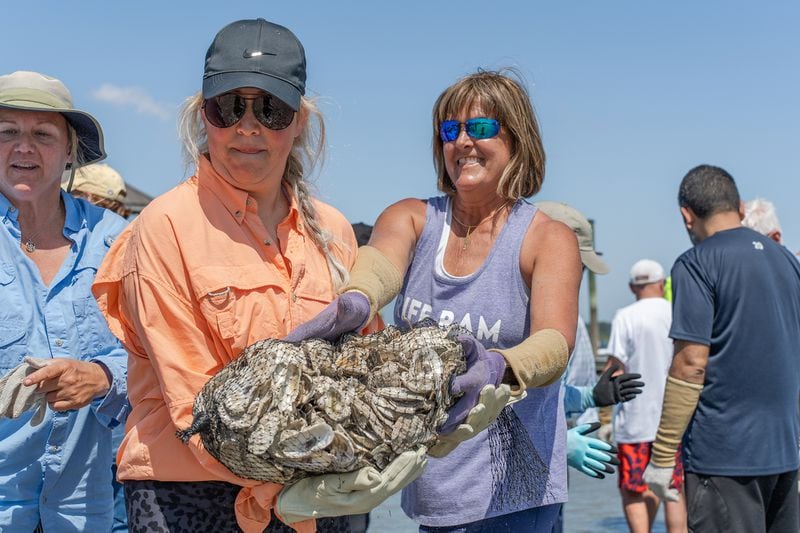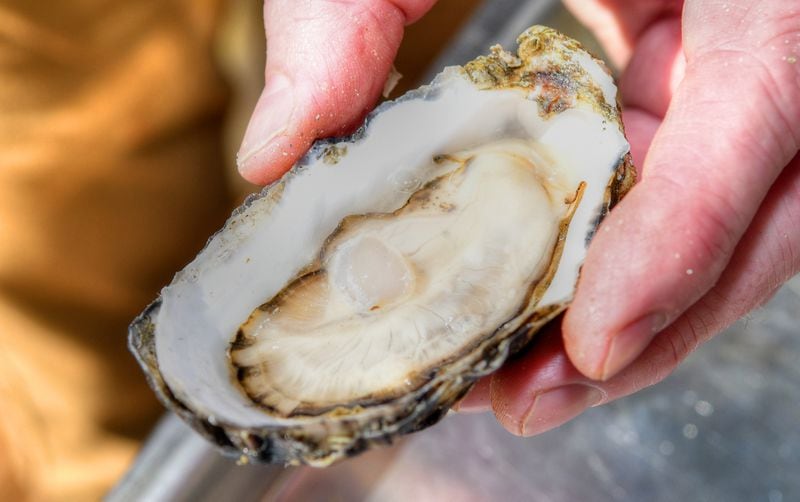Atlanta Journal Constitution. December 2022 print.
The one-room History Museum in the former Mount Carmel Baptist Church on Daufuskie Island, South Carolina, contains a sewing machine, rocking chairs, an old piano, coins, black-and-white photographs and other random artifacts that reflect life on the island. The provenance of those objects may have been lost over time, but there’s one object that has a history well documented: a poster featuring a Native American man wearing a feathered headdress advertising Daufuski Brand oysters.
Early in the 20th century, oysters processed on Daufuskie Island were sold all over the world. In the 1930s, advertisements for the brand appeared in newspapers across the country. According to Jenny Hersch, co-author of “Daufuskie Island — Images of America,” L.P Maggioni and Company opened an oyster factory on Daufuskie Island in the 1880s, employing island residents and workers from neighboring islands, as well as about 50 seasonal Polish workers.
“Men did the picking, while the women and children shucked the oysters. When Maggioni built the factory, all the harvesting, shucking and steaming was done on the island. Oysters from Daufuskie were packed in tin cans, put on ice and transported by boat to Bluffton and Savannah for sale,” said Hersch.
Additional oysters companies also operated on the island, too.
There are several theories for what led to the decline of Daufuskie’s oyster industry: unsanitary work conditions, pollution, better employment opportunities with the Works Progress Administration. The upshot is, the last oyster business on the island shut down in 1959.
Today, you can still purchase small red cans of Daufuski Brand smoked and boiled oysters at big box retailers such as Walmart, but they have little connection to their namesake island. In the 1970s, Maggioni contracted with a company in South Korea to source and package oysters and then sold the brand to Liberty Gold Fruit Company in California.
Harvesting wild oysters still continues recreationally on Daufuskie Island, although it’s unlikely the industry will ever make a comeback. Nevertheless, efforts are underway to celebrate the island’s oyster industry and to create new oyster habitats around the island.

Credit: Sucheta Rawal
Honoring history
Just 5 miles long and 2.5 miles wide, Daufuskie Island has no bridge to the mainland and only a few paved roads. Surrounded by oyster reefs, spartina grass, salt marshes and a rich habitat for the American alligator, loggerhead sea turtles, snowy egret and wood storks, this pristine island of sandy beaches, ancient oaks and Spanish moss is a Lowcountry wonderland where the pace of life slows to a crawl.
Inhabited for more than 9,000 years, the Yemassee indigenous people were its first known residents. When the Europeans arrived, they brought in enslaved populations to work the plantations. After the Emancipation Proclamation, freed slaves remained on the island where they cultivated a language and culture called Gullah, a blend of Southern English and African dialects and customs.
Today Daufuskie is home to about 300 full-time residents, 60% of whom live in the upscale community of Haig Point, while others live in the Historic District and smaller neighborhoods. Seven or eight families descendant from enslaved people remain on the island. Many of their family members worked in the oyster industry. Other descendants have moved away but still own ancestral land and houses.
Among the island’s newer residents is former Atlantan Sara Deitch, who started vacationing on Daufuskie in 1988 and moved there about 12 years ago. As a board member of the Daufuskie Island Historical Foundation, she works to preserve the history and culture of the island.
The Foundation’s latest initiative is the Oyster Union Society Hall, opening in spring 2023. Located in a two-story house built in the 1890s, it originally belonged to the family of James Peto Chaplin Jr., an affluent boat builder and oyster business owner, and was a popular gathering place for oyster workers. To help tell the story of the Brothers and Sisters Oyster Union Society, one of several benevolent societies on the island, the foundation restored the abandoned building and brought in artifacts, including shucking knives, membership ribbons and a bateau, a locally-built flat-bottom wooden boat.
While the Oyster Union Society Hall serves to preserve the island’s history, other efforts are in the works to protect the future of the island’s oyster habitats.

Credit: Handout
Coastal filters
In addition to having once played an integral role in the island’s economy, oysters are essential to Daufuskie’s environment, says Michael Hodges, a wildlife biologist with the South Carolina Department of Natural Resources. They act as filters that help maintain water quality in coastal zones, prevent intertidal banks from erosion and protect coastal marshes, one of the most productive ecosystems on the planet. One oyster filters up to 50 gallons of phytoplankton and sediment-filled water per day while creating essential habitat for a wide variety of marine species and birds.
“Part of Daufuskie Island is exposed to the Intracoastal Waterway. Boat traffic, winds and lack of shoreline stabilization materials lead to the island’s erosion,” said Hodges.
To mitigate erosion, improve water quality and maintain habitat, the South Carolina Department of Natural Resources (SCDNR) and South Carolina Oyster Restoration and Enhancement Program (SCORE) are working together to help coastal communities build oyster reefs.
SCORE has worked with more than 5,000 volunteers to build reefs at 133 sites along the coast of South Carolina over the past 20 years. One key requirement for DNR reef build locations is that the area be off-limits for harvesting. The artificial reefs are constructed strictly for serving the environment.
Reef builds take place in late spring through early summer before oysters reproduce, sending spawn into the water. When the larvae sink, they need to attach to a hard surface like oyster shells to grow. If they land on sand, they will not survive. Constructing man-made reefs with oyster shells creates a stable environment for the oysters to thrive and protect the environment. With the passage of each season, more oysters will propagate the vertical reef creating a self-sustaining habitat.
Visitors are welcome to volunteer on a Daufuskie Island oyster reef build, just be advised that heavy lifting is required. More than 350 bags of oyster shells, each weighing more than 30 pounds, are moved twice — first from the mainland at Bluffton to a marine vessel, and then from the vessel to the shoreline at Haig Point. A human chain of volunteers dressed in waterproof boots, gloves and hats help place the bags in the mid-intertidal zone, and then SCORE staff secure them so they don’t wash away in the rain, waves or wind. The process takes about three to four hours to complete.
In April 2022, a volunteer group of about 100 built a 65-foot reef along the Haig Point shoreline. The next reef build takes place May 4, 2023. Meanwhile, there are more immediate volunteer opportunities available, including shell cleanups, bagging, reef monitoring, outreach and education, which are conducted throughout the season.
Those interested in participating are advised to fill out a volunteer form at http://score.dnr.sc.gov/deep8493.html.

Credit: Chris Hunt
Island Flavors
Besides being good for the environment, oysters are delicious, and there are a number of ways to enjoy them while on Daufuskie.
Community organizations and Daufuskie Elementary School often host oyster roasts that are open to the public. Check the bulletin boards at the museum or Haig Point for announcements and details. It’s a great opportunity to meet locals and enjoy locally harvested oysters cooked on an open fire. Wash them down with locally crafted spirits from the Daufuskie Island Distillery.
You can also grab a plate of fried oysters and a deviled crab at the Old Daufuskie Crab Company. Or Haig Point members and guests can watch the sunset while enjoying raw oysters at the Calibogue Club, the island’s only fine dining restaurant.
So the next time you enjoy a succulent oyster on the half shell or oyster Rockefeller, think about how these small, odd-shaped mollusks not only nourishes your body but the environments they live in as well. By protecting their habitats, you can help safeguard the islands and all those who depend on them.
IF YOU GO
Daufuskie Island, South Carolina, is 280 miles southeast of Atlanta via I-75 and I-16. Access via boat from Bluffton, S.C., and Hilton Head Island, S.C.
Getting there
Daufuskie Island Ferry. $49.50 round-trip for day-time visitors, $60.50 roundtrip for overnight visitors. 35 Fording Island Road, Bluffton, S.C. 843-940-7704, daufuskieislandferry.com
Things to Do
History Museum. 10 a.m.-4 p.m. Tuesday-Saturday. Free. 44 Old Haig Point Road. 843-384-6363. daufuskiemuseum.org
Daufuskie Island Distillery. 11 a.m.-5 p.m. Tuesday-Saturday. Free. 270 Haig Point Road. 843-342-4786. daufuskierum.com
South Carolina Oyster Recycling and Enhancement Program.(SCORE). Inquire for volunteering opportunities. 843-953-9241. score.dnr.sc.gov
Where to Eat
Old Daufuskie Crab Company. Local seafood in an informal setting overlooking the Intracoastal Waterway. $8 and up. 256 Cooper River Landing Road. 843-785-6652. daufuskiedifference.com/restaurant
School Grounds. Small coffee shop located in the old lunchroom of the historic Mary Field School. $4 and up. 203 School Rod. 919-610-8808.
Where to Stay
Daufuskie Rental Group. Private vacation home rentals on the island start at $359 per night. 843-540-8986, vacationdaufuskiesc.com/rentals
Haig Point. Inclusive Discovery Visits featuring water taxi transport from Hilton Head Island; access to golf, equestrian and tennis facilities; food and beverage credits; and accommodations at the Strachan Mansion or the 1873 Lighthouse start at $699 per night. 10 Haig Point Circle, Hilton Head Island. 843-341-8104, haigpoint.com/discovery-visits
~ Written for and published by Atlanta Journal Constitution. All rights reserved.